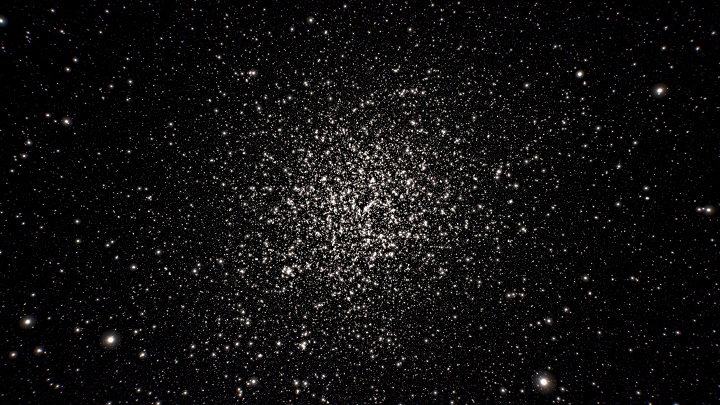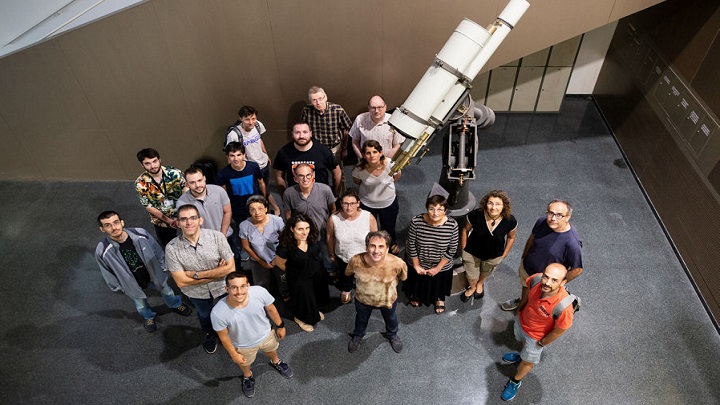Gaia mission identifies half a million new stars in Omega Centauri cluster
- The European Space Agency’s project to create the most ambitious stellar map of our galaxy reveals new insights into its largest star cluster
- Up to five Einstein crosses have been found, a space-time phenomenon that quadruples the image of a single object
- A group of IEEC researchers at the Institute of Cosmos Sciences of the University of Barcelona participated in the mission, which also detailed the position of more than 150,000 asteroids

Caption: Omega Centauri is the largest, brightest and most massive star cluster in the Milky Way.
Credits: ESA/Gaia/DPAC
Half a million new stars in Omega Centauri—the largest and most massive star cluster in our galaxy, the Milky Way—380 quasars seen through gravitational lenses and the defined position of more than 150,000 asteroids within the solar system. These are some of the exceptional advances announced today by the Gaia mission, the European Space Agency‘s (ESA) flagship project to detail the stellar mapping of our galaxy and broaden the global perspective of the cosmos around us.
The Gaia satellite is one of the most accurate and technologically advanced instruments ever built. It was launched into space in December 2013. Since the beginning, the mission has involved a team of experts led by Carme Jordi, Xavier Luri and Francesca Figueras, from the Faculty of Physics of the University of Barcelona (UB), the Institute of Cosmos Sciences of the University of Barcelona (ICCUB) and the Institute of Space Studies of Catalonia (IEEC).
A new star map for Omega Centauri
Omega Centauri is the largest and brightest globular star cluster in our galaxy, with about ten million stars. It lies in the constellation Centaurus, and its origin and evolution still baffle the astronomical community. But why has it been the subject of the Gaia mission?
“The Omega Centauri cluster is one of the nine regions of high stellar density studied by the Gaia mission. Globular clusters, one of the oldest objects in the Universe, are particularly valuable for reconstructing the Milky Way’s cosmic past. These bright objects, well visible in the sky, are still poorly understood and represent pieces of a gigantic cosmic puzzle that has yet to complete our knowledge of the Milky Way”, says the team from the IEEC at the ICCUB.
With the new results, the Omega Centauri star map adds half a million new sources revealed thanks to Gaia’s sophisticated observational mode for celestial mapping. This extends the previously known mapping—the nearly 1.8 billion stars revealed in June 2022 by the Gaia Data Release (DR3)—and makes it possible to create a complete, large-scale map of Omega Centauri with data on the positions, sky motions and brightness of the new stellar sources.
The exploration of eight other regions of high stellar density will also provide surprising results that will form part of the fourth Gaia Data Release (DR4), which will help to determine the age of the galaxy, as well as to test models of galactic evolution and, finally, to infer the possible age of the Universe itself.

Caption: The Gaia team of the University of Barcelona.
Credits: UB
Einstein crosses, an extraordinary space-time phenomenon
One of the most spectacular derivatives of Albert Einstein’s theory of general relativity is gravitational lensing. This is a phenomenon caused by the deflection of light passing close to massive objects (stars, galaxies, etc.) that generates a giant magnifying glass effect. Gravitational lenses—applied as research tools in astrophysics—can amplify the brightness of light and capture multiple astronomical images that reveal extraordinary clues about the origin of the Universe.
Gaia has now identified 381 quasars, whose light would be affected by gravitational lenses making them the most ambitious set of candidates yet discovered. Five of the possible lenses could be what are known as Einstein crosses, an exceptional space-time phenomenon that produces an image with four different components in the shape of a cross.
Asteroids, starlight and radial velocity
The mission has also defined the position of 156,823 asteroids—identified by the Gaia Data Release (DR3)—with previously unknown accuracy. In the future, Gaia DR4 will double the number of asteroids studied and complete the set with comets and planetary satellites to improve the knowledge of the small bodies in the nearest space.
Also noteworthy is the description of the dynamics of 10,000 red binary stars, which is crucial for calculating cosmic distances, confirming stellar characteristics and detailing how stars evolve in the Universe. Previously unpublished radial velocity data on variable stars, analysis of interstellar bands and updated astrometry of solar system objects complete the scientific advances announced prior to the release of Gaia DR4.
Thanks to the Gaia mission’s three data releases, we now have an innovative, multidimensional mapping view of the Milky Way, with unprecedented data on the positions, distances and motions of nearly two billion stars that will help to reveal the origin and evolution of our galaxy. The mission is redefining the foundations of astronomy, including in areas of astrophysics and cosmology not foreseen by the project. It relies on a large, international collaborative effort to collect and interpret a large volume of highly complex data to complete a final catalogue that will occupy a petabyte (one million gigabytes). The new Gaia discoveries advance results from what will be the fourth data release (DR4) to be made public no earlier than the end of 2025.
Press release prepared in collaboration with the University of Barcelona.
Contacts
IEEC Communication Office
Barcelona, Spain
E-mail: comunicacio@ieec.cat
About the IEEC
The Institute of Space Studies of Catalonia (IEEC — Institut d’Estudis Espacials de Catalunya) promotes and coordinates space research and technology development in Catalonia for the benefit of society. IEEC fosters collaborations both locally and worldwide and is an efficient agent of knowledge, innovation and technology transfer. As a result of more than 25 years of high-quality research, done in collaboration with major international organisations, IEEC ranks among the best international research centres, focusing on areas such as: astrophysics, cosmology, planetary science, and Earth Observation. IEEC’s engineering division develops instrumentation for ground- and space-based projects, and has extensive experience in working with private or public organisations from the aerospace and other innovation sectors.
The IEEC is a non-profit public sector foundation that was established in February 1996. It has a Board of Trustees composed of the Generalitat de Catalunya, Universitat de Barcelona (UB), Universitat Autònoma de Barcelona (UAB), Universitat Politècnica de Catalunya · BarcelonaTech (UPC), and the Spanish Research Council (CSIC). The IEEC is also a CERCA centre.
